OSTEOPOROSIS RATE IN EARLY BREAST CANCER PATIENTS UNDERGOING ENDOCRINE THERAPY AT MILITARY HOSPITAL 175
Main Article Content
Abstract
Background: Concomitant use of gonadotropin-releasing hormone analogues with tamoxifen in premenopausal women and Aromatase inhibitor in postmenopausal women causes rapid bone loss and an increased risk of fracture in breast cancer patients. Objectives: To investigate the prevalence of osteoporosis and factors related to the rate of bone deficiency and osteoporosis in breast cancer patients undergoing endocrine therapy who visited the Oncology Center of Military Hospital 175. Methods: A cross-sectional study surveyed 105 women with breast cancer who had undergone surgery and were undergoing endocrine treatment at Military Hospital 175 from December 1, 2020 to May 30, 2021. Measured bone density by DXA method with criteria for osteoporosis: -1.5 ≤ T-score < -2.5 and osteoporosis: T-score ≤ -2.5. Results: Bone deficiency accounted for 32.4% (CI 95%: 23.8-41.9) and osteoporosis accounted for 35.2% (95% CI: 25.7 - 44.8). Women aged ≥ 50 years with breast cancer had a 5.2 times higher risk of osteoporosis than women < 50 years old (95% CI: 1.1 – 26.4). Women using the hormone Ais had a 4.1 times higher risk of osteoporosis than women using Tamoxifen (95% CI: 1.01 – 16.2). Women who used medical ovarian inhibitors had an increased risk of osteoporosis 14.2 times (95% CI: 2.6 - 77.3). Conclusion: Women with breast cancer from the age of 50 who use hormonal drugs and use anti-ovarian drugs should be screened for osteoporosis periodically.
Article Details
Keywords
Osteoporosis, breast cancer, DXA
References
2. A. Muhammad (2018), "Postmenopausal osteoporosis and breast cancer: The biochemical links and beneficial effects of functional foods", Biomed Pharmacother. 107, 571-582.
3. Nguyễn Thị Hoài Châu (2001), "Khảo sát mật độ xương và tìm hiểu những yếu tố liên quan đến bệnh loãng xương của phụ nữ ở Thành phố Hồ Chí Minh và một số tỉnh miền Tây Nam Bộ", Tạp chí sinh lý học. 8(2), Tr 1-5.
4. S. Bailey J. Lin (2021), "The association of osteoporosis knowledge and beliefs with preventive behaviors in postmenopausal breast cancer survivors", BMC Womens Health. 21(1), 297.
5. L. F. Baccaro (2015), "The epidemiology and management of postmenopausal osteoporosis: a viewpoint from Brazil", Clin Interv Aging. 10, 583-91.
6. Hoàng Văn Dũng (2017), Nghiên cứu mật độ xương, các yếu tố nguy cơ loãng xương, sự thay đổi một số dấu ấn chu chuyển xương ở phụ nữ sau mãn kinh được bổ sung sữa đậu nành có tăng cường viatmin D và canxi tại cộng đồng, Luận án tiến sỹ Y học, Học Viện Quân Y, Hà Nội.
7. Dương Thanh Bình (2018), "Thực trạng loãng xương ở phụ nữ mãn kinh đến khám tại Bệnh viện Hữu Nghị Việt Nam - Cu Ba Đồng Hới", Tạp chí thông tin khoa học và công nghệ Quảng Bình. 5.
8. Nguyễn Trung Hòa và Cs (2011), "Tỷ lệ loãng xương và một số yếu tố liên quan ở người 45 tuổi trở lên tại thành phố Hồ Chí Minh, năm 2011", Tạp chí Y học dự phòng,. 12(7), Tr 93.


